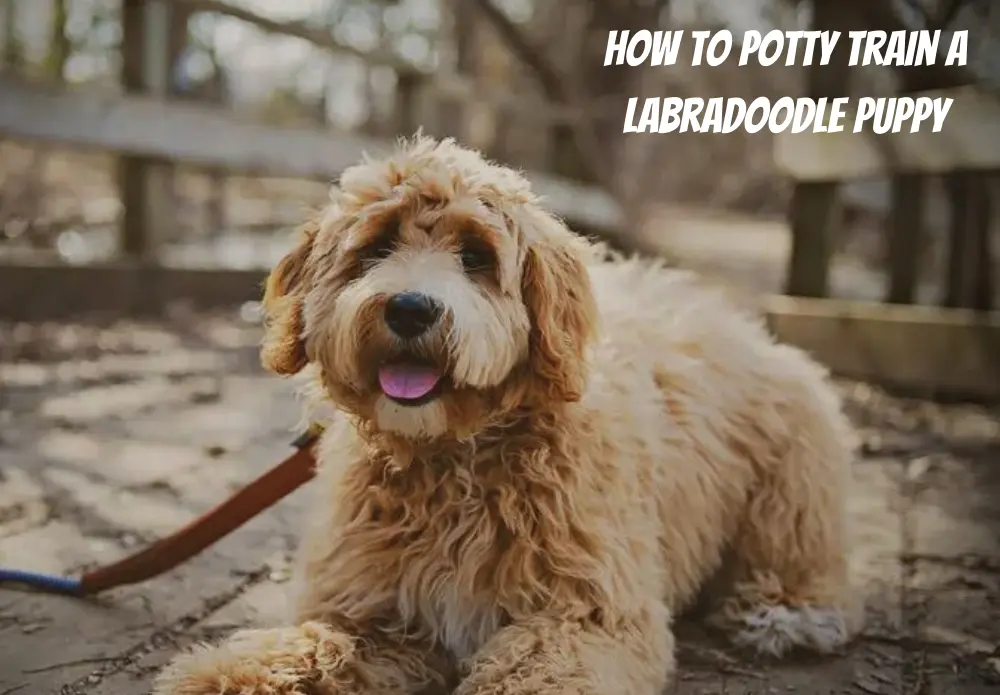If you have recently acquired one of these adorable bundles of joy and are proud of it, you should teach it one of the most fundamental and practical skills: potty training.
As a traditional family dog, the Labradoodle, you might choose to confine your new companion inside. This underscores how crucial it is to guarantee that they are housebroken.
How do you do it? You’ve arrived at the proper location. This post covers everything you need to know to train your Labradoodle to relieve itself in the proper locations. You only need to have a lot of love and some patience.
Continue reading to find out how to housebreak a Labradoodle.
How To Potty Train A Labradoodle Puppy
Are you ready to begin? Here are some background details to assist you with housebreaking your new dog.
The Best Time To Start Potty Training
This is crucial to consider because puppies’ bladders are smaller, and they might not yet have complete control over them, necessitating a little more tolerance and understanding.
Like many other dogs, elderly Labradoodles can be more difficult to housebreak, but if you have a puppy, you can begin housebreaking them at 4 to 6 months old.
How Long Does It Take To Potty Train A Labradoodle Puppy
The Labradoodle is a naturally intelligent breed, and housebreaking will take 4 to 5 months. Making the process simpler for you and your dog starts with consistent training and using appropriate techniques.
It’s crucial to understand the indications that your dog needs to relieve himself before we get into how to start teaching your dog. By identifying them, you’ll be able to take advantage of spontaneous training chances and take your dog outside before a mess is made.
Signs Your Labradoodle Needs To Go
The following are some typical behaviors to watch out for, some of which you may already know.
Sniffing the Floor Continuously
Bring your dog outside if you notice it is constantly sniffing the ground. Before going potty, dogs have a habit of sniffing the ground. They can frequently be spotted sniffing for a place to leave their scent behind because they are highly particular about where they go.
Whining and Barking
Occasionally, your dog will whimper and bark to let you know it must go outside. As Labradoodle experience the urge to urinate or defecate, they may be symptoms of discomfort.
Going in Circles
Another sign that your dog needs to go outside is this. A dog’s natural tendency is to check the area where it would defecate to make sure it is secure and free from predators. It’s time to let your dog out if you notice them walking in close quarters.
Methods for Training Labradoodles
You may housetrain your Labradoodle in a variety of ways. We suggest the following 3 techniques. Select the one you think will work best for you:
First Method: Using Commands
Commands are a tried-and-true, traditional potty-training technique that helps us communicate with our dogs and let them know what is expected of them.
How To Do It
Initially, this strategy calls for you to walk your dog every three hours and 10 to 30 minutes after eating. Most dogs have regular schedules for going potty, so these intervals fit with them.
You’ll also need to choose words like “go potty” or “shazam” while training your dog with commands. Whatever you decide to use, as long as you use it consistently, doesn’t matter. A leash and a designated poop and potty area are also required.
Use the leash to lead your dog to your chosen destination when it’s time to go outside. Your dog will eventually learn to connect the action with the word when you command it.
Even if installing and using a dog door is appealing, you should resist doing so while they are still learning the command. The likelihood is high that they will utilize the door without understanding the command or what is expected.
Second Method: Ringing a bell
One of the more impressive ways to train your Labradoodle has to be this. Every time your dog has to use the restroom outside, you can teach it to ring a bell.
How To Do It
You’ll be pleasantly pleased by how simple it is to educate your dog this way, even though it requires them to carry out a certain behavior. All you have to do is fasten a bell like this to your door so it will ring whenever you leave.
Your perceptive Labradoodle will eventually link the noise to going outside. Teach your dog to ring the doorbell independently. To do this, place a treat close to the bell, wait for your dog to ring it, and then give your pet the treat and lots of praise.
Labradoodles are playful, so they might ring the bell frequently even if they don’t need to go outside. Allow them to leave even though something occurs. Consistency is crucial, as we’ve already established. Sooner or later, your pet will get bored with the game and ring the bell to tell you when it needs to go potty.
Third method: crate training
Another well-known technique for potty training is crate training. It is predicated on the notion that dogs dislike going potty in their sleeping or comfortable spaces.
During the first few months of life, when mum would clean the space when it got dirty, puppies normally learn that excrement doesn’t belong in their beds.
Thanks to this technique, your dog will have a safe haven as they settle into their new home.
How To Do It
You’ll require a sizable crate to house your Labradoodle. Ensure your dog can stand, turn around, and lie in it without discomfort. Your Labradoodle should be able to sense its surroundings while inside the crate, including sounds and smells.
With this technique, you must immediately take your dog outside when it needs to relieve itself. The upside is that when your pet is confined to a crate, watching out for the behaviors we outlined before is much simpler.
You can let it out even before your dog sniffs and circles. In the morning, when they first wake up, when they are enthusiastic, and right after meals, dogs typically need to go.
Depending on the dog, crate training might take days or weeks to be effective. Younger dogs will require more frequent walks than senior canines.
Make their space more inviting in the box to help them associate it with good feelings. They will adore their crates if you put their favorite toy, a beautiful pillow, or a mat inside.
Tips for Potty-training Success
Do you know which training technique you intend to employ? You’ll want to integrate these helpful hints while you educate your dog to make the process go more quickly and smoothly.
The following points should be remembered:
Tip #1: Maintain a Consistent Schedule
Keeping a regular feeding plan is one of the greatest ways to determine when your Labradoodle needs to go. Your dog will learn to expect meals if you provide them simultaneously daily. They’ll also have more regular bowel motions.
You may also include set times for walks and playtime to increase consistency and provide the physical and mental stimulation that healthy dogs require.
Tip #2: Treats and More Treats!
You can take advantage of the labradoodles’ robust appetite while potty-training them. Regardless of your strategy, please encourage them to study and perform by providing them with enticing and nutritious snacks.
You can also give them compliments and belly massages to show how happy you are with them because Labradoodles inherit the poodle parent’s eager-to-please personality.
Pro Tip: Reward your dog immediately if it rings the bell, goes potty on cue, or does so shortly after being let out of the crate. This will help them learn to connect the activity with the reward.
Tip #3: Build a Strong Bond
This must be one of the most delightful suggestions because it involves spending time with your Labradoodle and cuddling with it. Your dog will thrive by having a positive relationship with you as their owner, and they’ll want to please you regarding housebreaking.
By feeding your dog with your hands, you can create a close bond with it. This works very well on timid and nervous dogs.
Dogs are social creatures by nature and adore their owners. Establish a solid and gratifying relationship with your new dog, whether through playing with it, taking it for walks, giving it lots of rubs, or simply relaxing on the couch with your four-legged friend.
The chance is also a great way to get to know your dog better. Every dog is unique, so getting to know your dog’s specific mannerisms, habits, preferences, and dislikes will help you with training and developing a strong bond.
Tip #4: When You Can’t Go Outside, Use Pee Pads
This advice will be helpful for those of you who reside in apartment complexes without convenient access to outdoor space. Use pee pads and train your dog to poop and pee on them if you cannot go outside for any reason. Use them as your dog’s designated area for discharging by following the same procedures.
When you aren’t at home and can’t let your dog outside, pee pads are also helpful. You may rest easy knowing that your Labradoodle will know what to do even if it cannot go outside by training it to use them.
Pee pads are also considerably more pleasant and easier to handle than washing your floor.
Tip #5: Make Learning Fun
You can encourage your pet to equate obeying commands with good feelings by acting as their owner. How? Please spend some time playing with your Labradoodle after it has finished its business of releasing itself.
Learn what activities they enjoy most and reward them by participating in them.
Tip #6: Patience, Patience, and More Patience
The most important rule is patient with your pet throughout the procedure. Even though it seems like a simple and useful lesson, it may take some time for Labradoodles to comprehend what we expect of them. If your dog has never been trained, remember that everything is new to them.
Despite its difficulties, teaching a child to use the toilet is worthwhile. Just consider the difference between a trained dog and an untrained dog.
It will also help you build a deep bond with them and make it simpler if you want to teach them more tricks in the future if you are patient with them as they learn.
Conclusion
It doesn’t seem difficult now that you know some fundamental techniques and advice for toilet training your Labradoodle. Remember to be patient, consistent, provide your dog with a set schedule, and promptly praise your pet whenever appropriate.
As you practice these potty training suggestions, your connection with your dog will improve, and your home will see fewer unpleasant accidents. If your dog occasionally falls short, keep working with it; eventually, your Labradoodle will figure out what you want it to accomplish.






